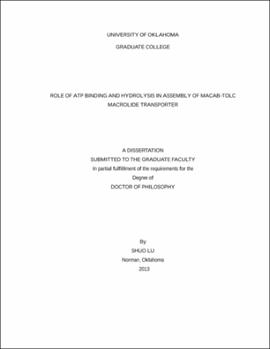| dc.contributor.advisor | Zgurskaya, Helen I | |
| dc.creator | Lu, Shuo | |
| dc.date.accessioned | 2019-05-01T17:23:56Z | |
| dc.date.available | 2019-05-01T17:23:56Z | |
| dc.date.issued | 2013 | |
| dc.identifier | 99124782102042 | |
| dc.identifier.uri | https://hdl.handle.net/11244/319438 | |
| dc.description.abstract | In Gram-negative bacteria, intrinsic antibiotic resistance is provided by three component efflux transporters. In Escherichia coli, MacAB-TolC is the first experimentally described ATP-driven tripartite efflux pump responsible for macrolide resistance and enterotoxin secretion (Kobayashi, Nishino et al. 2001; Yamanaka, Kobayashi et al. 2008). In this complex, MacB is the inner membrane (IM) ABC-type (ATP-Binding Cassette) transporter which utilizes the energy from ATP hydrolysis for the transport of substrates. MacB functions together with a periplasmic membrane fusion protein (MFP) MacA. MacA stimulates the ATPase activity of MacB by inducing the closure of the nucleotide binding domains (NBD) of MacB (Modali and Zgurskaya 2011). TolC, as a versatile outer membrane (OM) channel, forms complex with MacAB to facilitate the extrusion of substrates into the exterior environment. Up to now it is still unclear how MacAB and TolC associate with each other contributing to the export of substrates, as well as how the presence of ATP and substrates affects the functions of this complex. | |
| dc.description.abstract | The first part of this dissertation focuses on understanding the mechanism of complex assembly of MacAB-TolC and the role of ATP in this process. We developed a real-time assay for the analysis of concurrent ATP hydrolysis and assembly of MacAB-TolC using surface plasmon resonance (SPR) technique. We found that MacB binds nucleotides with fast on- and off- rates and a low millimolar affinity. MacA-MacB forms a stable complex with nanomolar affinity and the binding of ATP increases the affinity of MacA-MacB interactions. These results strongly suggest that the binding of ATP brings MacB into a conformation with higher affinity towards MacA. Furthermore, the MacA-MacB complex remains unchanged during ATP hydrolysis cycle. We also found that the large periplasmic loop (LPL) of MacB is required for the MacA-dependent stimulation of MacB ATPse and the recruitment of TolC into the complex by MacA. Based on these findings, we propose a mechanism of complex assembly of MacAB-TolC complex. MacA has a higher affinity towards the ATP-bound state of MacB and promotes the closed conformation of MacB NBD for ATP hydrolysis. The MacA-dependent stimulation of MacB ATPase is coupled to the recruitment of TolC by MacA through the interactions between MacA and MacB LPL. | |
| dc.description.abstract | The second part of this dissertation focuses on developing a new method for the study of membrane protein complex MacAB-TolC. For this purpose we reconstituted MacAB-TolC into lipid nanodiscs. We found that MacB containing nanodiscs can bind and hydrolyze ATP, suggesting that MacB is functional in nanodiscs. Interestingly, MacBC56A/D643C, which only exhibits 60% MacB ATPase compared to that of MacBWT in detergent, shows ATPase activity similar to MacBWT in nanodiscs. We conclude that reconstitution of MacB into lipid nanodiscs provides a more native environmen to investigate the biological and physiological functions of MacB and the mechanism of assembly of MacAB-TolC complex. | |
| dc.format.extent | 132 pages | |
| dc.format.medium | application.pdf | |
| dc.language | en_US | |
| dc.relation.requires | Adobe Acrobat Reader | |
| dc.subject | ATP-binding cassette transporters | |
| dc.subject | Macrolide antibiotics | |
| dc.subject | Membrane proteins | |
| dc.title | Role of ATP binding and hydrolysis in assembly of MacAB-TolC macrolide transporter | |
| dc.type | text | |
| dc.type | document | |
| dc.thesis.degree | Ph.D. | |
| ou.group | College of Arts and Sciences::Department of Chemistry and Biochemistry | |
